Public Health and Safety Implications of Housing and Buildings Report
VerifiedAdded on 2020/12/24
|14
|4214
|158
Report
AI Summary
This report provides a comprehensive overview of the public health implications of housing and buildings. It delves into the multifaceted relationship between health and housing, emphasizing the importance of healthy housing structures free from hazards. The report identifies various housing hazards, including cold, heat, falls, and dampness/moulds, and discusses their adverse impacts on public health. It highlights the role of the Building Code of Australia (BCA) in setting standards for safety, amenity, and health. The report also examines public health regulations, nuisance issues related to housing, and the leaky building syndrome, outlining the associated health risks and legal actions. The report also includes the legal actions that can be taken against individuals who create a nuisance by damaging someone's property or causing trouble.
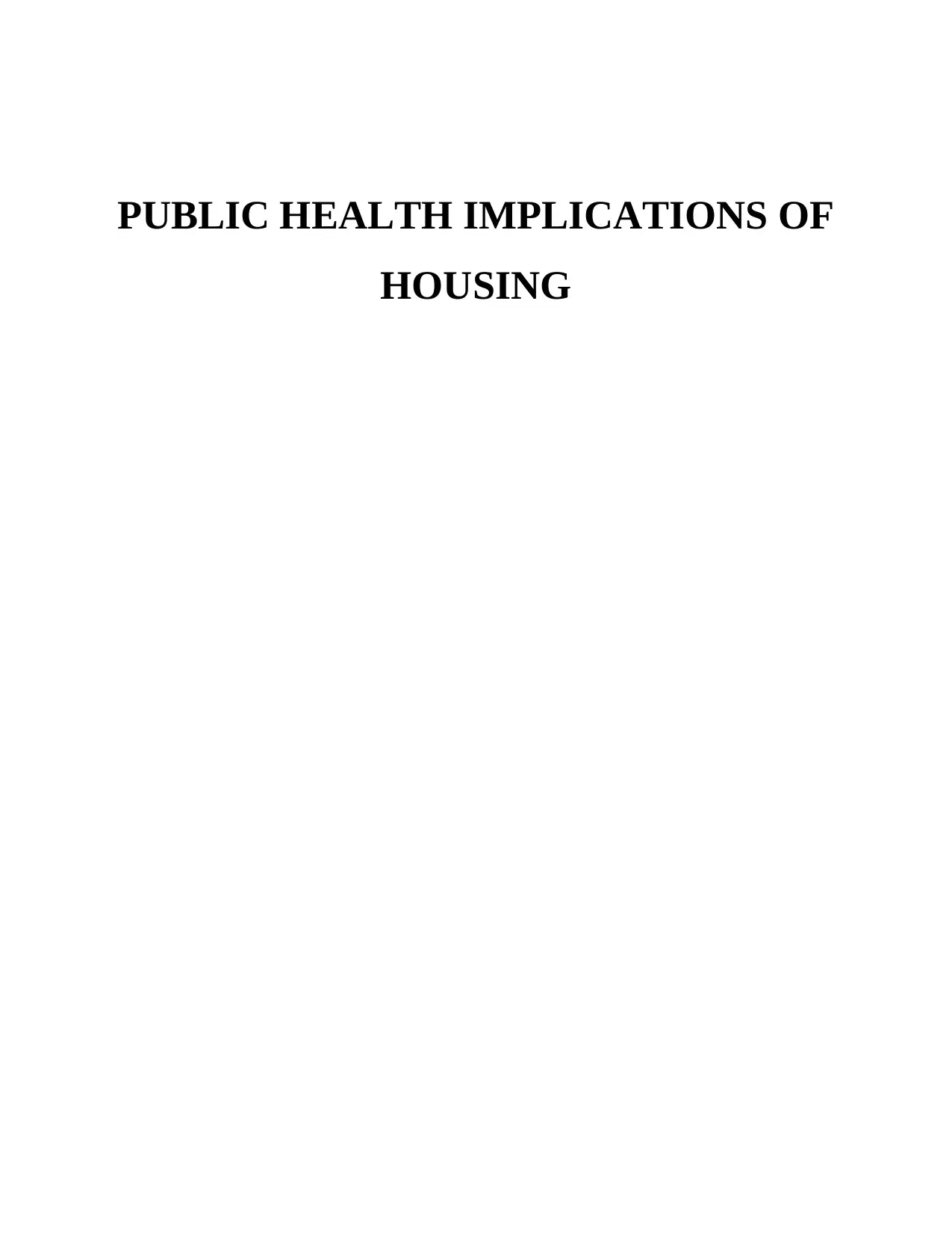
PUBLIC HEALTH IMPLICATIONS OF
HOUSING
HOUSING
Paraphrase This Document
Need a fresh take? Get an instant paraphrase of this document with our AI Paraphraser
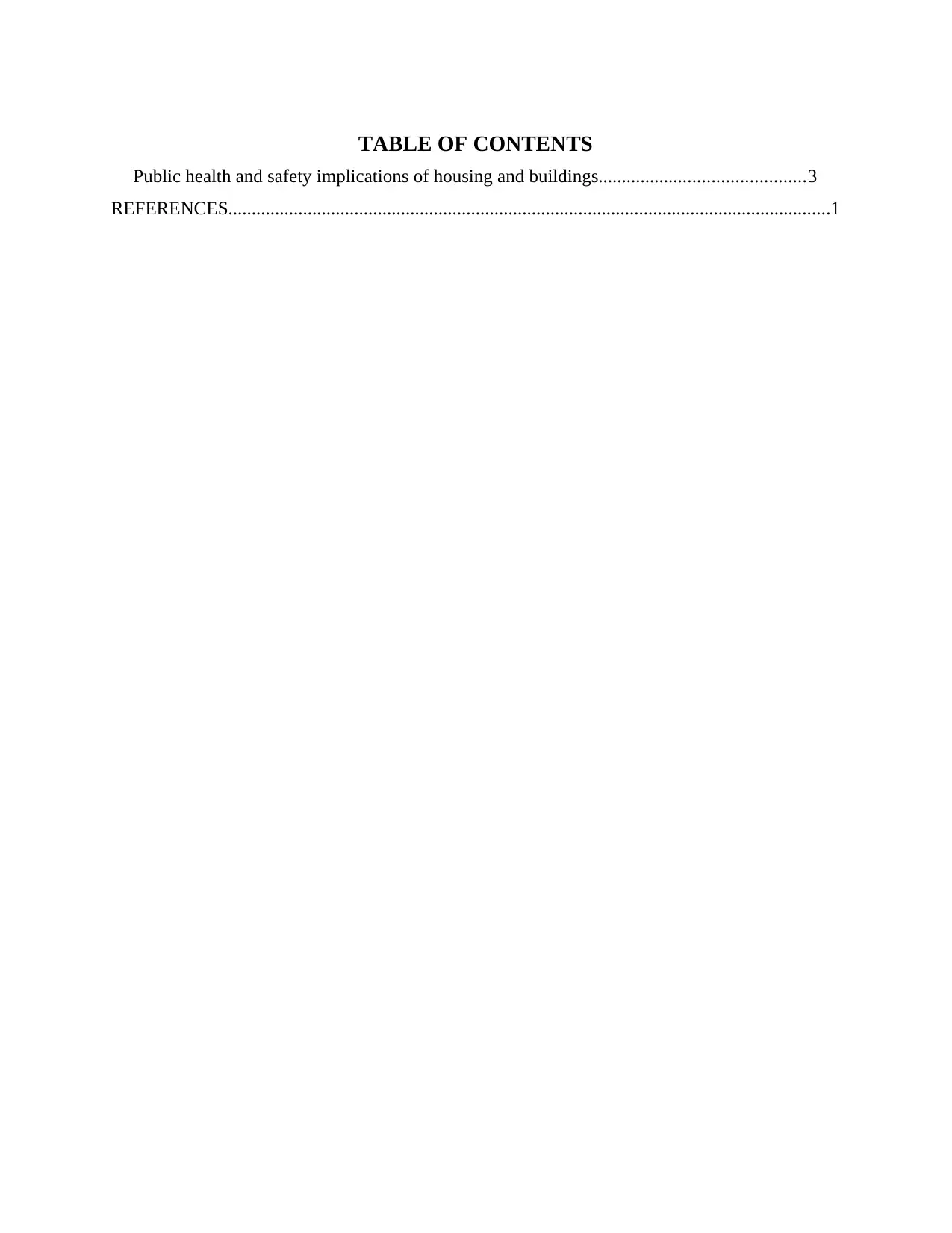
TABLE OF CONTENTS
Public health and safety implications of housing and buildings............................................3
REFERENCES.................................................................................................................................1
Public health and safety implications of housing and buildings............................................3
REFERENCES.................................................................................................................................1
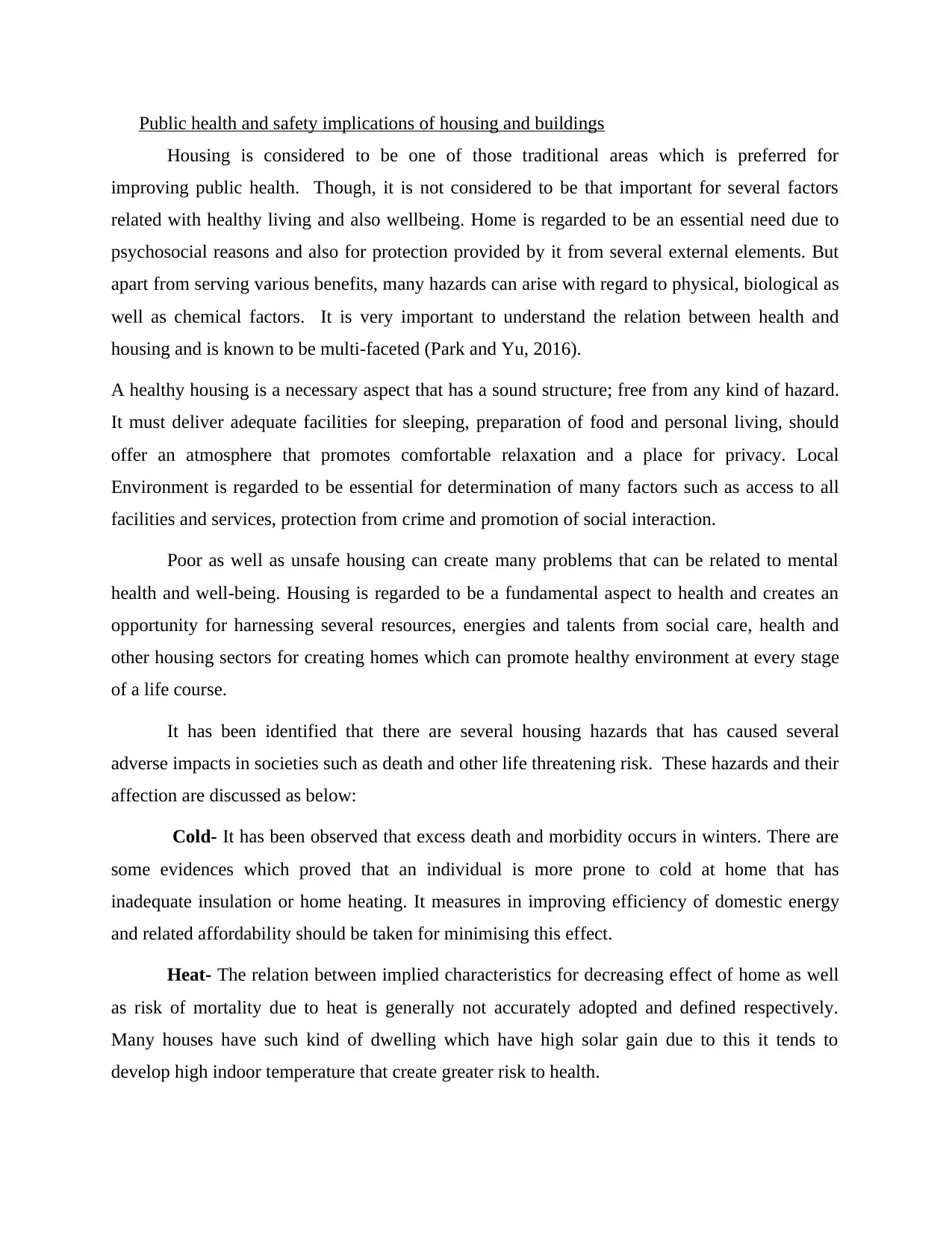
Public health and safety implications of housing and buildings
Housing is considered to be one of those traditional areas which is preferred for
improving public health. Though, it is not considered to be that important for several factors
related with healthy living and also wellbeing. Home is regarded to be an essential need due to
psychosocial reasons and also for protection provided by it from several external elements. But
apart from serving various benefits, many hazards can arise with regard to physical, biological as
well as chemical factors. It is very important to understand the relation between health and
housing and is known to be multi-faceted (Park and Yu, 2016).
A healthy housing is a necessary aspect that has a sound structure; free from any kind of hazard.
It must deliver adequate facilities for sleeping, preparation of food and personal living, should
offer an atmosphere that promotes comfortable relaxation and a place for privacy. Local
Environment is regarded to be essential for determination of many factors such as access to all
facilities and services, protection from crime and promotion of social interaction.
Poor as well as unsafe housing can create many problems that can be related to mental
health and well-being. Housing is regarded to be a fundamental aspect to health and creates an
opportunity for harnessing several resources, energies and talents from social care, health and
other housing sectors for creating homes which can promote healthy environment at every stage
of a life course.
It has been identified that there are several housing hazards that has caused several
adverse impacts in societies such as death and other life threatening risk. These hazards and their
affection are discussed as below:
Cold- It has been observed that excess death and morbidity occurs in winters. There are
some evidences which proved that an individual is more prone to cold at home that has
inadequate insulation or home heating. It measures in improving efficiency of domestic energy
and related affordability should be taken for minimising this effect.
Heat- The relation between implied characteristics for decreasing effect of home as well
as risk of mortality due to heat is generally not accurately adopted and defined respectively.
Many houses have such kind of dwelling which have high solar gain due to this it tends to
develop high indoor temperature that create greater risk to health.
Housing is considered to be one of those traditional areas which is preferred for
improving public health. Though, it is not considered to be that important for several factors
related with healthy living and also wellbeing. Home is regarded to be an essential need due to
psychosocial reasons and also for protection provided by it from several external elements. But
apart from serving various benefits, many hazards can arise with regard to physical, biological as
well as chemical factors. It is very important to understand the relation between health and
housing and is known to be multi-faceted (Park and Yu, 2016).
A healthy housing is a necessary aspect that has a sound structure; free from any kind of hazard.
It must deliver adequate facilities for sleeping, preparation of food and personal living, should
offer an atmosphere that promotes comfortable relaxation and a place for privacy. Local
Environment is regarded to be essential for determination of many factors such as access to all
facilities and services, protection from crime and promotion of social interaction.
Poor as well as unsafe housing can create many problems that can be related to mental
health and well-being. Housing is regarded to be a fundamental aspect to health and creates an
opportunity for harnessing several resources, energies and talents from social care, health and
other housing sectors for creating homes which can promote healthy environment at every stage
of a life course.
It has been identified that there are several housing hazards that has caused several
adverse impacts in societies such as death and other life threatening risk. These hazards and their
affection are discussed as below:
Cold- It has been observed that excess death and morbidity occurs in winters. There are
some evidences which proved that an individual is more prone to cold at home that has
inadequate insulation or home heating. It measures in improving efficiency of domestic energy
and related affordability should be taken for minimising this effect.
Heat- The relation between implied characteristics for decreasing effect of home as well
as risk of mortality due to heat is generally not accurately adopted and defined respectively.
Many houses have such kind of dwelling which have high solar gain due to this it tends to
develop high indoor temperature that create greater risk to health.
⊘ This is a preview!⊘
Do you want full access?
Subscribe today to unlock all pages.

Trusted by 1+ million students worldwide
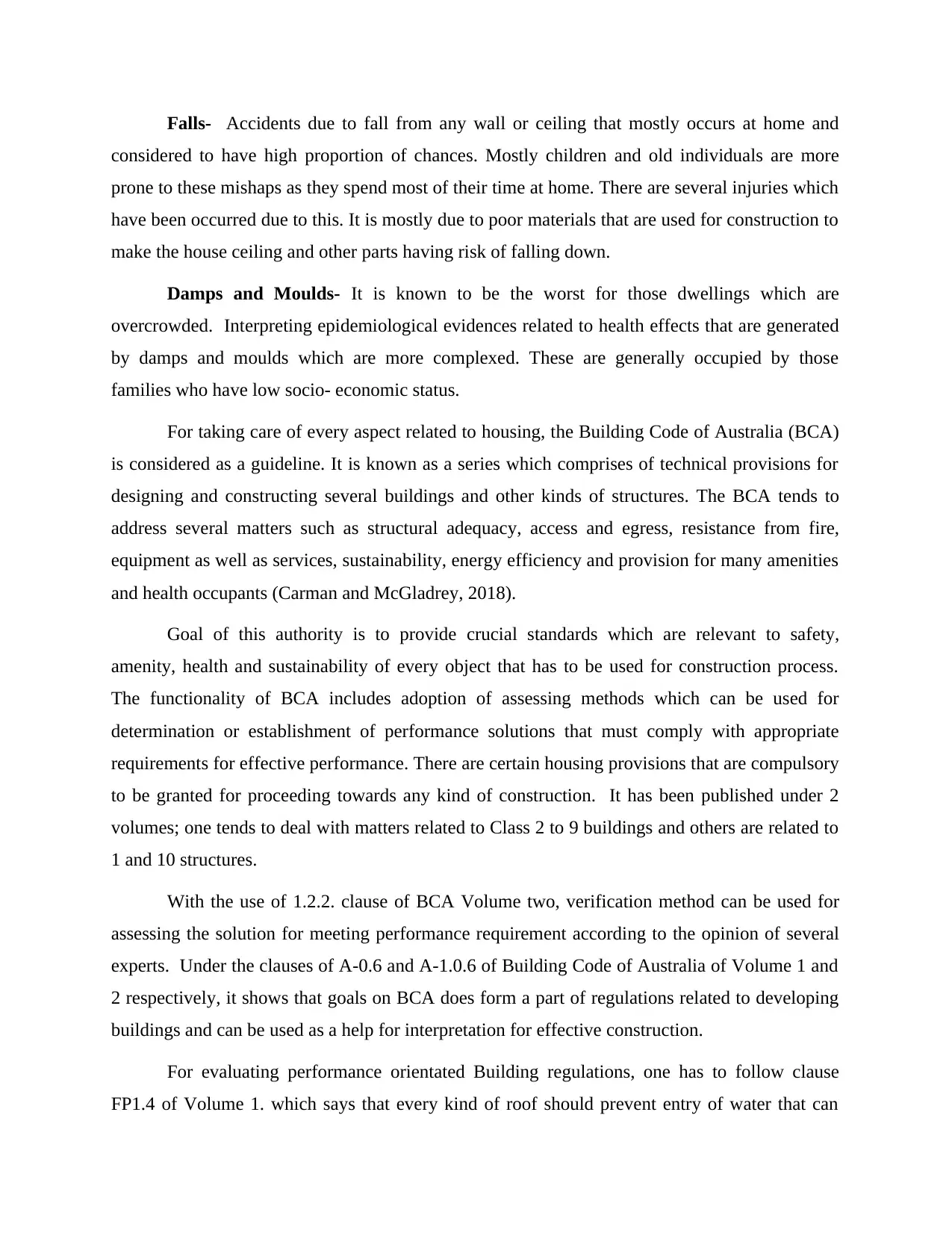
Falls- Accidents due to fall from any wall or ceiling that mostly occurs at home and
considered to have high proportion of chances. Mostly children and old individuals are more
prone to these mishaps as they spend most of their time at home. There are several injuries which
have been occurred due to this. It is mostly due to poor materials that are used for construction to
make the house ceiling and other parts having risk of falling down.
Damps and Moulds- It is known to be the worst for those dwellings which are
overcrowded. Interpreting epidemiological evidences related to health effects that are generated
by damps and moulds which are more complexed. These are generally occupied by those
families who have low socio- economic status.
For taking care of every aspect related to housing, the Building Code of Australia (BCA)
is considered as a guideline. It is known as a series which comprises of technical provisions for
designing and constructing several buildings and other kinds of structures. The BCA tends to
address several matters such as structural adequacy, access and egress, resistance from fire,
equipment as well as services, sustainability, energy efficiency and provision for many amenities
and health occupants (Carman and McGladrey, 2018).
Goal of this authority is to provide crucial standards which are relevant to safety,
amenity, health and sustainability of every object that has to be used for construction process.
The functionality of BCA includes adoption of assessing methods which can be used for
determination or establishment of performance solutions that must comply with appropriate
requirements for effective performance. There are certain housing provisions that are compulsory
to be granted for proceeding towards any kind of construction. It has been published under 2
volumes; one tends to deal with matters related to Class 2 to 9 buildings and others are related to
1 and 10 structures.
With the use of 1.2.2. clause of BCA Volume two, verification method can be used for
assessing the solution for meeting performance requirement according to the opinion of several
experts. Under the clauses of A-0.6 and A-1.0.6 of Building Code of Australia of Volume 1 and
2 respectively, it shows that goals on BCA does form a part of regulations related to developing
buildings and can be used as a help for interpretation for effective construction.
For evaluating performance orientated Building regulations, one has to follow clause
FP1.4 of Volume 1. which says that every kind of roof should prevent entry of water that can
considered to have high proportion of chances. Mostly children and old individuals are more
prone to these mishaps as they spend most of their time at home. There are several injuries which
have been occurred due to this. It is mostly due to poor materials that are used for construction to
make the house ceiling and other parts having risk of falling down.
Damps and Moulds- It is known to be the worst for those dwellings which are
overcrowded. Interpreting epidemiological evidences related to health effects that are generated
by damps and moulds which are more complexed. These are generally occupied by those
families who have low socio- economic status.
For taking care of every aspect related to housing, the Building Code of Australia (BCA)
is considered as a guideline. It is known as a series which comprises of technical provisions for
designing and constructing several buildings and other kinds of structures. The BCA tends to
address several matters such as structural adequacy, access and egress, resistance from fire,
equipment as well as services, sustainability, energy efficiency and provision for many amenities
and health occupants (Carman and McGladrey, 2018).
Goal of this authority is to provide crucial standards which are relevant to safety,
amenity, health and sustainability of every object that has to be used for construction process.
The functionality of BCA includes adoption of assessing methods which can be used for
determination or establishment of performance solutions that must comply with appropriate
requirements for effective performance. There are certain housing provisions that are compulsory
to be granted for proceeding towards any kind of construction. It has been published under 2
volumes; one tends to deal with matters related to Class 2 to 9 buildings and others are related to
1 and 10 structures.
With the use of 1.2.2. clause of BCA Volume two, verification method can be used for
assessing the solution for meeting performance requirement according to the opinion of several
experts. Under the clauses of A-0.6 and A-1.0.6 of Building Code of Australia of Volume 1 and
2 respectively, it shows that goals on BCA does form a part of regulations related to developing
buildings and can be used as a help for interpretation for effective construction.
For evaluating performance orientated Building regulations, one has to follow clause
FP1.4 of Volume 1. which says that every kind of roof should prevent entry of water that can
Paraphrase This Document
Need a fresh take? Get an instant paraphrase of this document with our AI Paraphraser
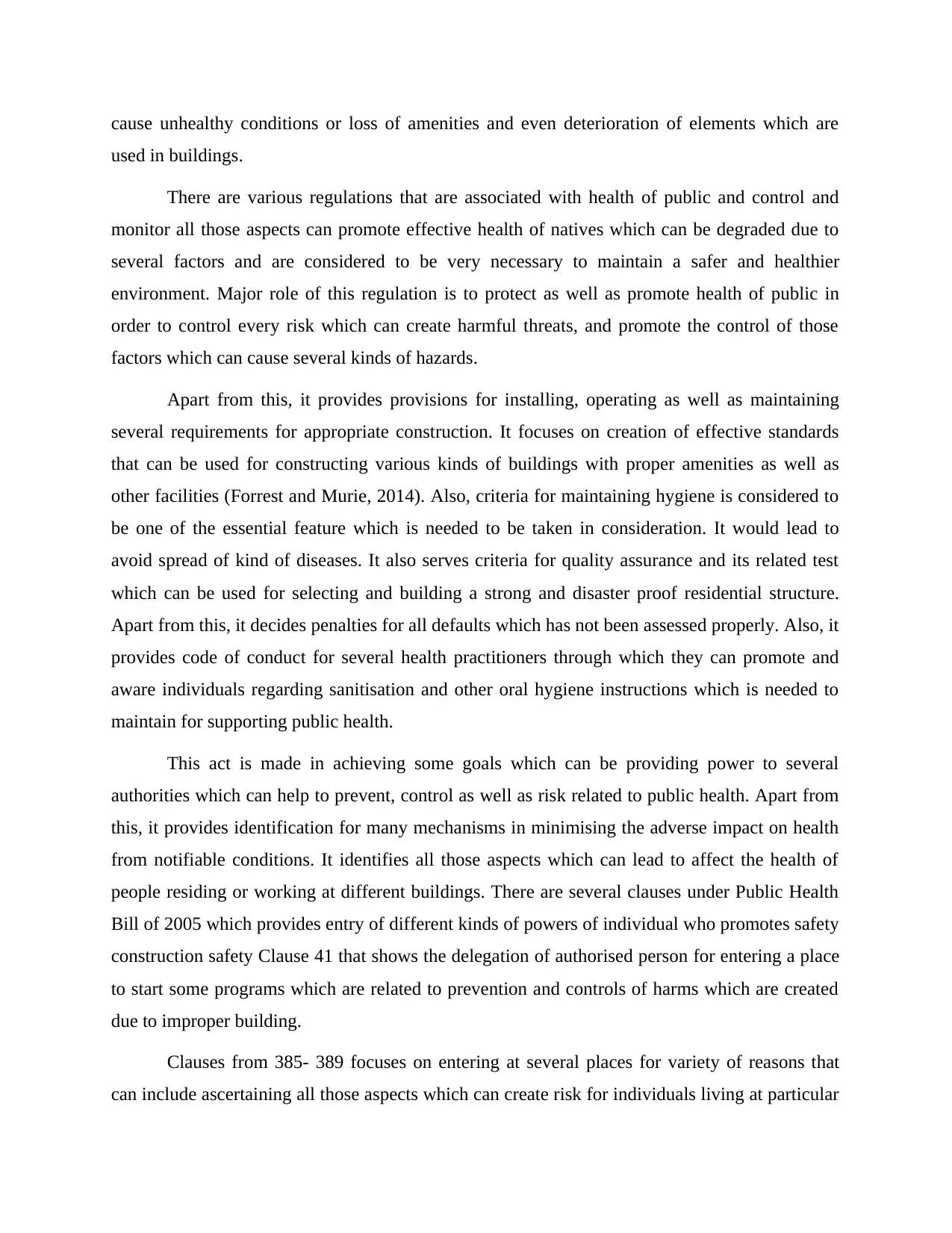
cause unhealthy conditions or loss of amenities and even deterioration of elements which are
used in buildings.
There are various regulations that are associated with health of public and control and
monitor all those aspects can promote effective health of natives which can be degraded due to
several factors and are considered to be very necessary to maintain a safer and healthier
environment. Major role of this regulation is to protect as well as promote health of public in
order to control every risk which can create harmful threats, and promote the control of those
factors which can cause several kinds of hazards.
Apart from this, it provides provisions for installing, operating as well as maintaining
several requirements for appropriate construction. It focuses on creation of effective standards
that can be used for constructing various kinds of buildings with proper amenities as well as
other facilities (Forrest and Murie, 2014). Also, criteria for maintaining hygiene is considered to
be one of the essential feature which is needed to be taken in consideration. It would lead to
avoid spread of kind of diseases. It also serves criteria for quality assurance and its related test
which can be used for selecting and building a strong and disaster proof residential structure.
Apart from this, it decides penalties for all defaults which has not been assessed properly. Also, it
provides code of conduct for several health practitioners through which they can promote and
aware individuals regarding sanitisation and other oral hygiene instructions which is needed to
maintain for supporting public health.
This act is made in achieving some goals which can be providing power to several
authorities which can help to prevent, control as well as risk related to public health. Apart from
this, it provides identification for many mechanisms in minimising the adverse impact on health
from notifiable conditions. It identifies all those aspects which can lead to affect the health of
people residing or working at different buildings. There are several clauses under Public Health
Bill of 2005 which provides entry of different kinds of powers of individual who promotes safety
construction safety Clause 41 that shows the delegation of authorised person for entering a place
to start some programs which are related to prevention and controls of harms which are created
due to improper building.
Clauses from 385- 389 focuses on entering at several places for variety of reasons that
can include ascertaining all those aspects which can create risk for individuals living at particular
used in buildings.
There are various regulations that are associated with health of public and control and
monitor all those aspects can promote effective health of natives which can be degraded due to
several factors and are considered to be very necessary to maintain a safer and healthier
environment. Major role of this regulation is to protect as well as promote health of public in
order to control every risk which can create harmful threats, and promote the control of those
factors which can cause several kinds of hazards.
Apart from this, it provides provisions for installing, operating as well as maintaining
several requirements for appropriate construction. It focuses on creation of effective standards
that can be used for constructing various kinds of buildings with proper amenities as well as
other facilities (Forrest and Murie, 2014). Also, criteria for maintaining hygiene is considered to
be one of the essential feature which is needed to be taken in consideration. It would lead to
avoid spread of kind of diseases. It also serves criteria for quality assurance and its related test
which can be used for selecting and building a strong and disaster proof residential structure.
Apart from this, it decides penalties for all defaults which has not been assessed properly. Also, it
provides code of conduct for several health practitioners through which they can promote and
aware individuals regarding sanitisation and other oral hygiene instructions which is needed to
maintain for supporting public health.
This act is made in achieving some goals which can be providing power to several
authorities which can help to prevent, control as well as risk related to public health. Apart from
this, it provides identification for many mechanisms in minimising the adverse impact on health
from notifiable conditions. It identifies all those aspects which can lead to affect the health of
people residing or working at different buildings. There are several clauses under Public Health
Bill of 2005 which provides entry of different kinds of powers of individual who promotes safety
construction safety Clause 41 that shows the delegation of authorised person for entering a place
to start some programs which are related to prevention and controls of harms which are created
due to improper building.
Clauses from 385- 389 focuses on entering at several places for variety of reasons that
can include ascertaining all those aspects which can create risk for individuals living at particular
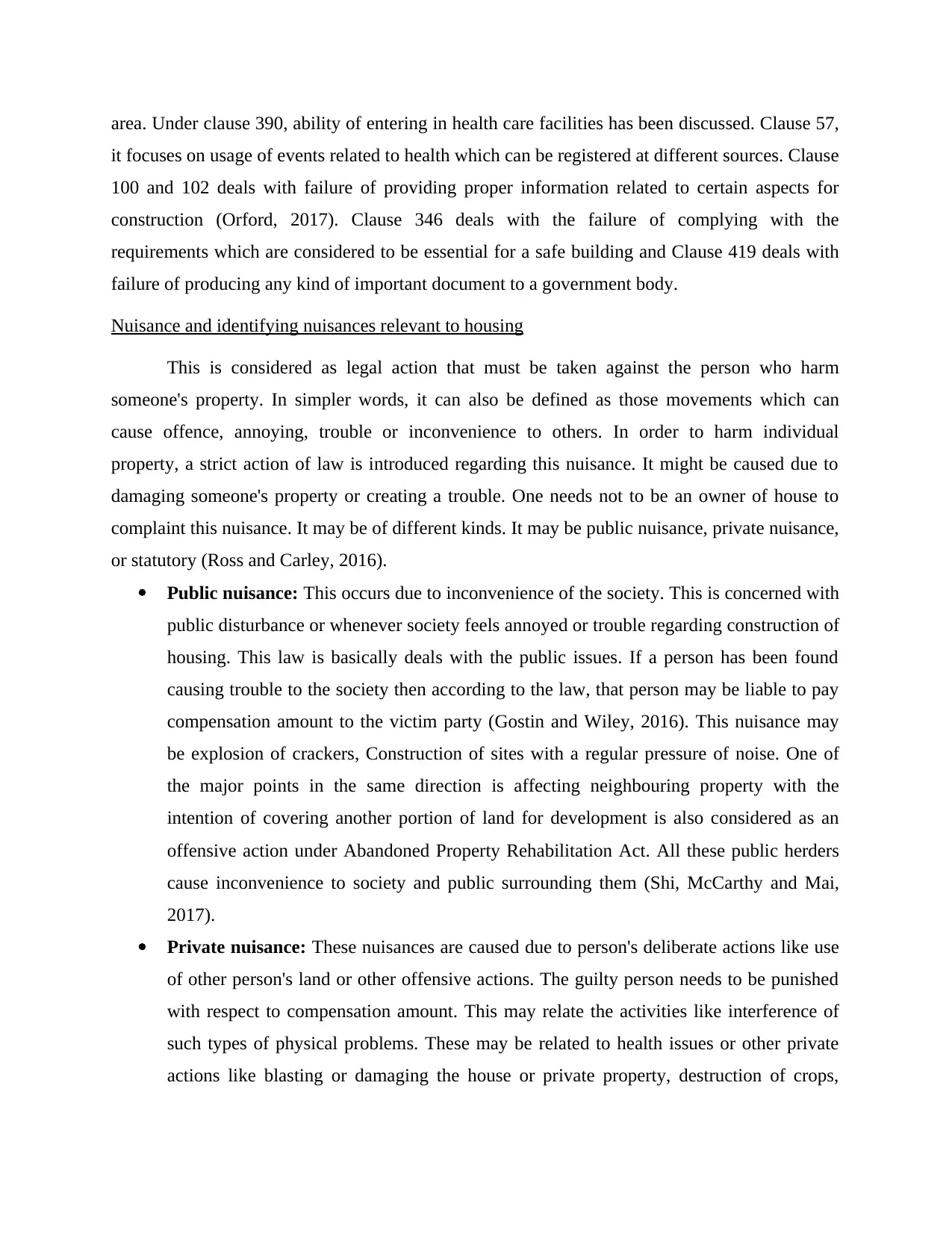
area. Under clause 390, ability of entering in health care facilities has been discussed. Clause 57,
it focuses on usage of events related to health which can be registered at different sources. Clause
100 and 102 deals with failure of providing proper information related to certain aspects for
construction (Orford, 2017). Clause 346 deals with the failure of complying with the
requirements which are considered to be essential for a safe building and Clause 419 deals with
failure of producing any kind of important document to a government body.
Nuisance and identifying nuisances relevant to housing
This is considered as legal action that must be taken against the person who harm
someone's property. In simpler words, it can also be defined as those movements which can
cause offence, annoying, trouble or inconvenience to others. In order to harm individual
property, a strict action of law is introduced regarding this nuisance. It might be caused due to
damaging someone's property or creating a trouble. One needs not to be an owner of house to
complaint this nuisance. It may be of different kinds. It may be public nuisance, private nuisance,
or statutory (Ross and Carley, 2016).
Public nuisance: This occurs due to inconvenience of the society. This is concerned with
public disturbance or whenever society feels annoyed or trouble regarding construction of
housing. This law is basically deals with the public issues. If a person has been found
causing trouble to the society then according to the law, that person may be liable to pay
compensation amount to the victim party (Gostin and Wiley, 2016). This nuisance may
be explosion of crackers, Construction of sites with a regular pressure of noise. One of
the major points in the same direction is affecting neighbouring property with the
intention of covering another portion of land for development is also considered as an
offensive action under Abandoned Property Rehabilitation Act. All these public herders
cause inconvenience to society and public surrounding them (Shi, McCarthy and Mai,
2017).
Private nuisance: These nuisances are caused due to person's deliberate actions like use
of other person's land or other offensive actions. The guilty person needs to be punished
with respect to compensation amount. This may relate the activities like interference of
such types of physical problems. These may be related to health issues or other private
actions like blasting or damaging the house or private property, destruction of crops,
it focuses on usage of events related to health which can be registered at different sources. Clause
100 and 102 deals with failure of providing proper information related to certain aspects for
construction (Orford, 2017). Clause 346 deals with the failure of complying with the
requirements which are considered to be essential for a safe building and Clause 419 deals with
failure of producing any kind of important document to a government body.
Nuisance and identifying nuisances relevant to housing
This is considered as legal action that must be taken against the person who harm
someone's property. In simpler words, it can also be defined as those movements which can
cause offence, annoying, trouble or inconvenience to others. In order to harm individual
property, a strict action of law is introduced regarding this nuisance. It might be caused due to
damaging someone's property or creating a trouble. One needs not to be an owner of house to
complaint this nuisance. It may be of different kinds. It may be public nuisance, private nuisance,
or statutory (Ross and Carley, 2016).
Public nuisance: This occurs due to inconvenience of the society. This is concerned with
public disturbance or whenever society feels annoyed or trouble regarding construction of
housing. This law is basically deals with the public issues. If a person has been found
causing trouble to the society then according to the law, that person may be liable to pay
compensation amount to the victim party (Gostin and Wiley, 2016). This nuisance may
be explosion of crackers, Construction of sites with a regular pressure of noise. One of
the major points in the same direction is affecting neighbouring property with the
intention of covering another portion of land for development is also considered as an
offensive action under Abandoned Property Rehabilitation Act. All these public herders
cause inconvenience to society and public surrounding them (Shi, McCarthy and Mai,
2017).
Private nuisance: These nuisances are caused due to person's deliberate actions like use
of other person's land or other offensive actions. The guilty person needs to be punished
with respect to compensation amount. This may relate the activities like interference of
such types of physical problems. These may be related to health issues or other private
actions like blasting or damaging the house or private property, destruction of crops,
⊘ This is a preview!⊘
Do you want full access?
Subscribe today to unlock all pages.

Trusted by 1+ million students worldwide
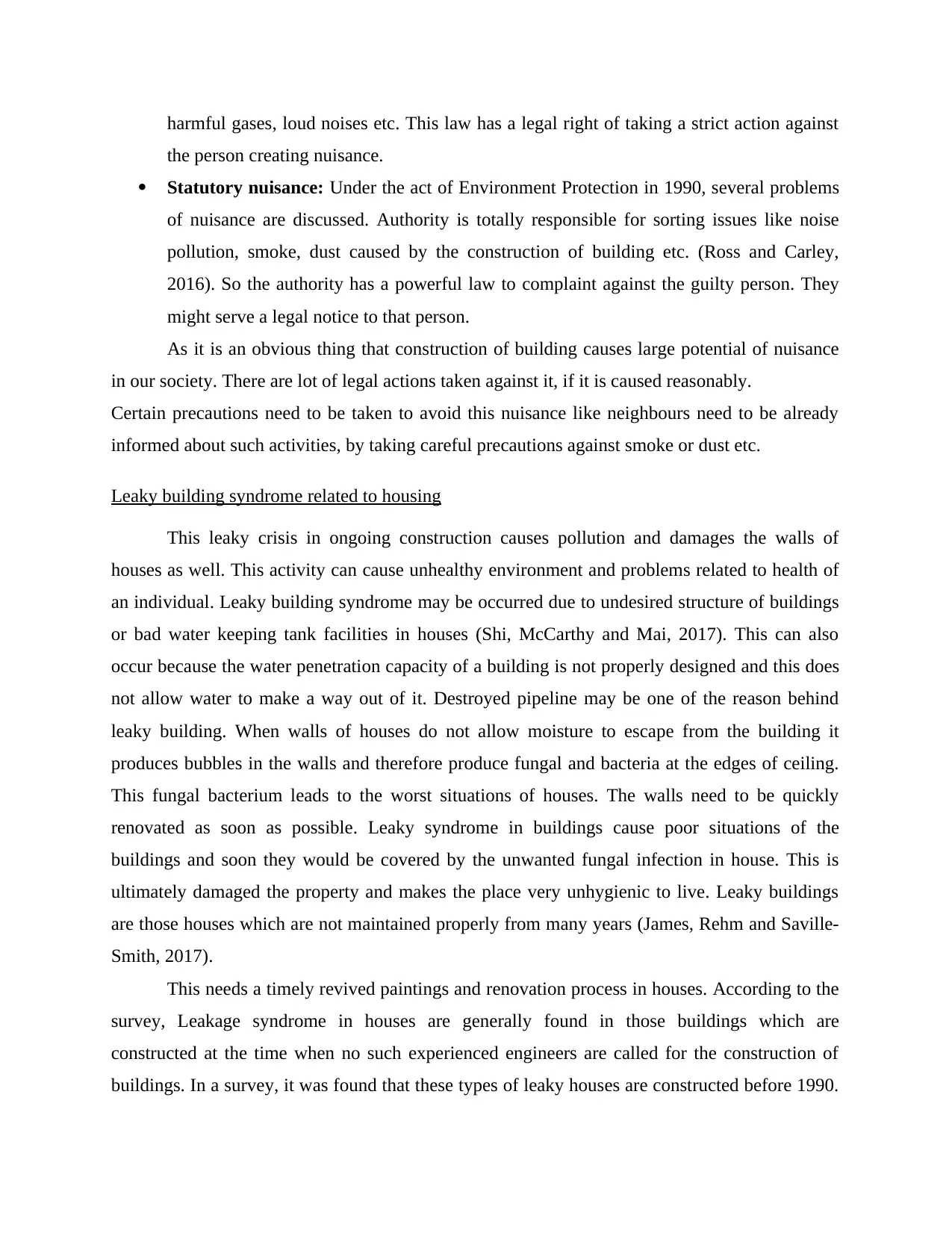
harmful gases, loud noises etc. This law has a legal right of taking a strict action against
the person creating nuisance.
Statutory nuisance: Under the act of Environment Protection in 1990, several problems
of nuisance are discussed. Authority is totally responsible for sorting issues like noise
pollution, smoke, dust caused by the construction of building etc. (Ross and Carley,
2016). So the authority has a powerful law to complaint against the guilty person. They
might serve a legal notice to that person.
As it is an obvious thing that construction of building causes large potential of nuisance
in our society. There are lot of legal actions taken against it, if it is caused reasonably.
Certain precautions need to be taken to avoid this nuisance like neighbours need to be already
informed about such activities, by taking careful precautions against smoke or dust etc.
Leaky building syndrome related to housing
This leaky crisis in ongoing construction causes pollution and damages the walls of
houses as well. This activity can cause unhealthy environment and problems related to health of
an individual. Leaky building syndrome may be occurred due to undesired structure of buildings
or bad water keeping tank facilities in houses (Shi, McCarthy and Mai, 2017). This can also
occur because the water penetration capacity of a building is not properly designed and this does
not allow water to make a way out of it. Destroyed pipeline may be one of the reason behind
leaky building. When walls of houses do not allow moisture to escape from the building it
produces bubbles in the walls and therefore produce fungal and bacteria at the edges of ceiling.
This fungal bacterium leads to the worst situations of houses. The walls need to be quickly
renovated as soon as possible. Leaky syndrome in buildings cause poor situations of the
buildings and soon they would be covered by the unwanted fungal infection in house. This is
ultimately damaged the property and makes the place very unhygienic to live. Leaky buildings
are those houses which are not maintained properly from many years (James, Rehm and Saville-
Smith, 2017).
This needs a timely revived paintings and renovation process in houses. According to the
survey, Leakage syndrome in houses are generally found in those buildings which are
constructed at the time when no such experienced engineers are called for the construction of
buildings. In a survey, it was found that these types of leaky houses are constructed before 1990.
the person creating nuisance.
Statutory nuisance: Under the act of Environment Protection in 1990, several problems
of nuisance are discussed. Authority is totally responsible for sorting issues like noise
pollution, smoke, dust caused by the construction of building etc. (Ross and Carley,
2016). So the authority has a powerful law to complaint against the guilty person. They
might serve a legal notice to that person.
As it is an obvious thing that construction of building causes large potential of nuisance
in our society. There are lot of legal actions taken against it, if it is caused reasonably.
Certain precautions need to be taken to avoid this nuisance like neighbours need to be already
informed about such activities, by taking careful precautions against smoke or dust etc.
Leaky building syndrome related to housing
This leaky crisis in ongoing construction causes pollution and damages the walls of
houses as well. This activity can cause unhealthy environment and problems related to health of
an individual. Leaky building syndrome may be occurred due to undesired structure of buildings
or bad water keeping tank facilities in houses (Shi, McCarthy and Mai, 2017). This can also
occur because the water penetration capacity of a building is not properly designed and this does
not allow water to make a way out of it. Destroyed pipeline may be one of the reason behind
leaky building. When walls of houses do not allow moisture to escape from the building it
produces bubbles in the walls and therefore produce fungal and bacteria at the edges of ceiling.
This fungal bacterium leads to the worst situations of houses. The walls need to be quickly
renovated as soon as possible. Leaky syndrome in buildings cause poor situations of the
buildings and soon they would be covered by the unwanted fungal infection in house. This is
ultimately damaged the property and makes the place very unhygienic to live. Leaky buildings
are those houses which are not maintained properly from many years (James, Rehm and Saville-
Smith, 2017).
This needs a timely revived paintings and renovation process in houses. According to the
survey, Leakage syndrome in houses are generally found in those buildings which are
constructed at the time when no such experienced engineers are called for the construction of
buildings. In a survey, it was found that these types of leaky houses are constructed before 1990.
Paraphrase This Document
Need a fresh take? Get an instant paraphrase of this document with our AI Paraphraser
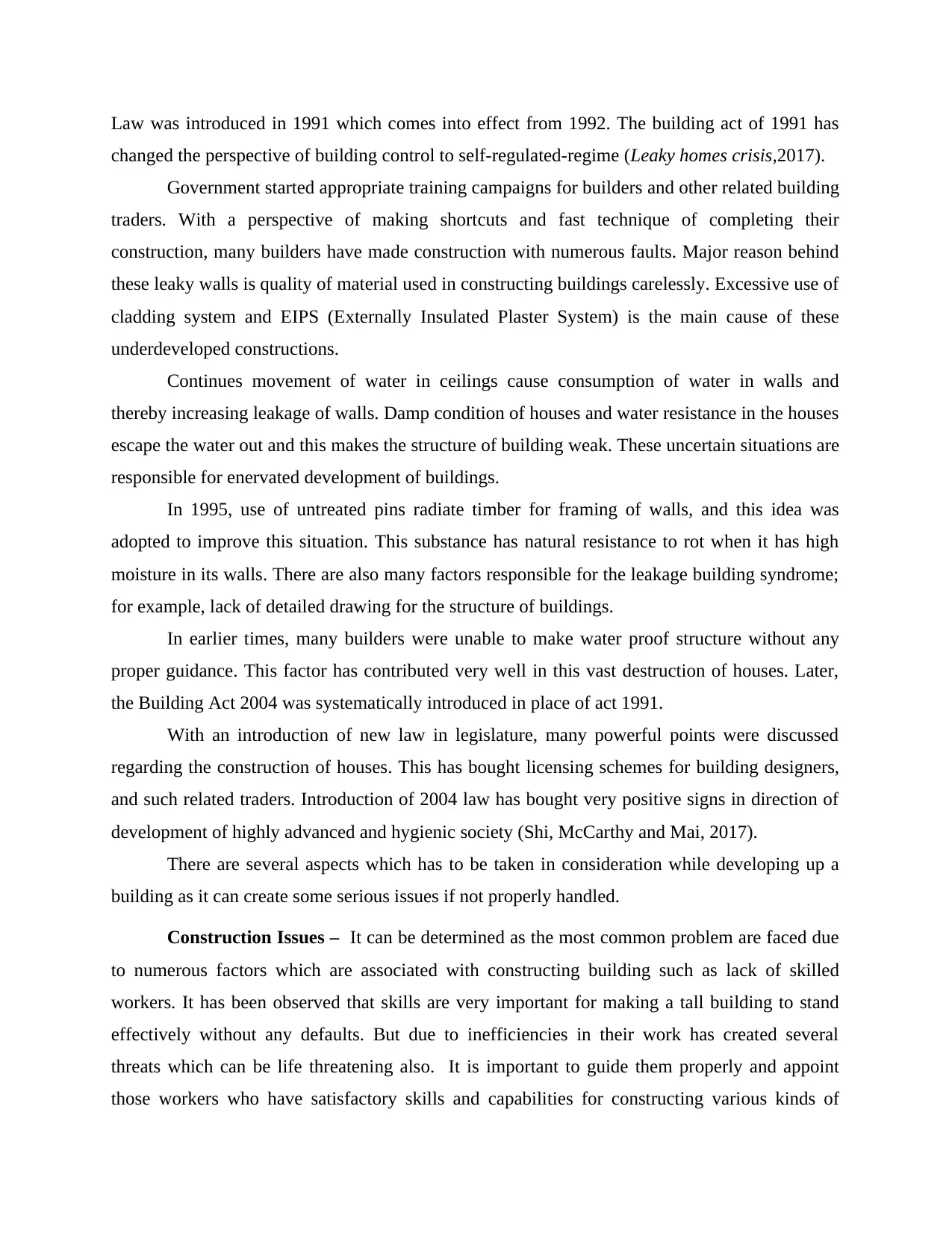
Law was introduced in 1991 which comes into effect from 1992. The building act of 1991 has
changed the perspective of building control to self-regulated-regime (Leaky homes crisis,2017).
Government started appropriate training campaigns for builders and other related building
traders. With a perspective of making shortcuts and fast technique of completing their
construction, many builders have made construction with numerous faults. Major reason behind
these leaky walls is quality of material used in constructing buildings carelessly. Excessive use of
cladding system and EIPS (Externally Insulated Plaster System) is the main cause of these
underdeveloped constructions.
Continues movement of water in ceilings cause consumption of water in walls and
thereby increasing leakage of walls. Damp condition of houses and water resistance in the houses
escape the water out and this makes the structure of building weak. These uncertain situations are
responsible for enervated development of buildings.
In 1995, use of untreated pins radiate timber for framing of walls, and this idea was
adopted to improve this situation. This substance has natural resistance to rot when it has high
moisture in its walls. There are also many factors responsible for the leakage building syndrome;
for example, lack of detailed drawing for the structure of buildings.
In earlier times, many builders were unable to make water proof structure without any
proper guidance. This factor has contributed very well in this vast destruction of houses. Later,
the Building Act 2004 was systematically introduced in place of act 1991.
With an introduction of new law in legislature, many powerful points were discussed
regarding the construction of houses. This has bought licensing schemes for building designers,
and such related traders. Introduction of 2004 law has bought very positive signs in direction of
development of highly advanced and hygienic society (Shi, McCarthy and Mai, 2017).
There are several aspects which has to be taken in consideration while developing up a
building as it can create some serious issues if not properly handled.
Construction Issues – It can be determined as the most common problem are faced due
to numerous factors which are associated with constructing building such as lack of skilled
workers. It has been observed that skills are very important for making a tall building to stand
effectively without any defaults. But due to inefficiencies in their work has created several
threats which can be life threatening also. It is important to guide them properly and appoint
those workers who have satisfactory skills and capabilities for constructing various kinds of
changed the perspective of building control to self-regulated-regime (Leaky homes crisis,2017).
Government started appropriate training campaigns for builders and other related building
traders. With a perspective of making shortcuts and fast technique of completing their
construction, many builders have made construction with numerous faults. Major reason behind
these leaky walls is quality of material used in constructing buildings carelessly. Excessive use of
cladding system and EIPS (Externally Insulated Plaster System) is the main cause of these
underdeveloped constructions.
Continues movement of water in ceilings cause consumption of water in walls and
thereby increasing leakage of walls. Damp condition of houses and water resistance in the houses
escape the water out and this makes the structure of building weak. These uncertain situations are
responsible for enervated development of buildings.
In 1995, use of untreated pins radiate timber for framing of walls, and this idea was
adopted to improve this situation. This substance has natural resistance to rot when it has high
moisture in its walls. There are also many factors responsible for the leakage building syndrome;
for example, lack of detailed drawing for the structure of buildings.
In earlier times, many builders were unable to make water proof structure without any
proper guidance. This factor has contributed very well in this vast destruction of houses. Later,
the Building Act 2004 was systematically introduced in place of act 1991.
With an introduction of new law in legislature, many powerful points were discussed
regarding the construction of houses. This has bought licensing schemes for building designers,
and such related traders. Introduction of 2004 law has bought very positive signs in direction of
development of highly advanced and hygienic society (Shi, McCarthy and Mai, 2017).
There are several aspects which has to be taken in consideration while developing up a
building as it can create some serious issues if not properly handled.
Construction Issues – It can be determined as the most common problem are faced due
to numerous factors which are associated with constructing building such as lack of skilled
workers. It has been observed that skills are very important for making a tall building to stand
effectively without any defaults. But due to inefficiencies in their work has created several
threats which can be life threatening also. It is important to guide them properly and appoint
those workers who have satisfactory skills and capabilities for constructing various kinds of
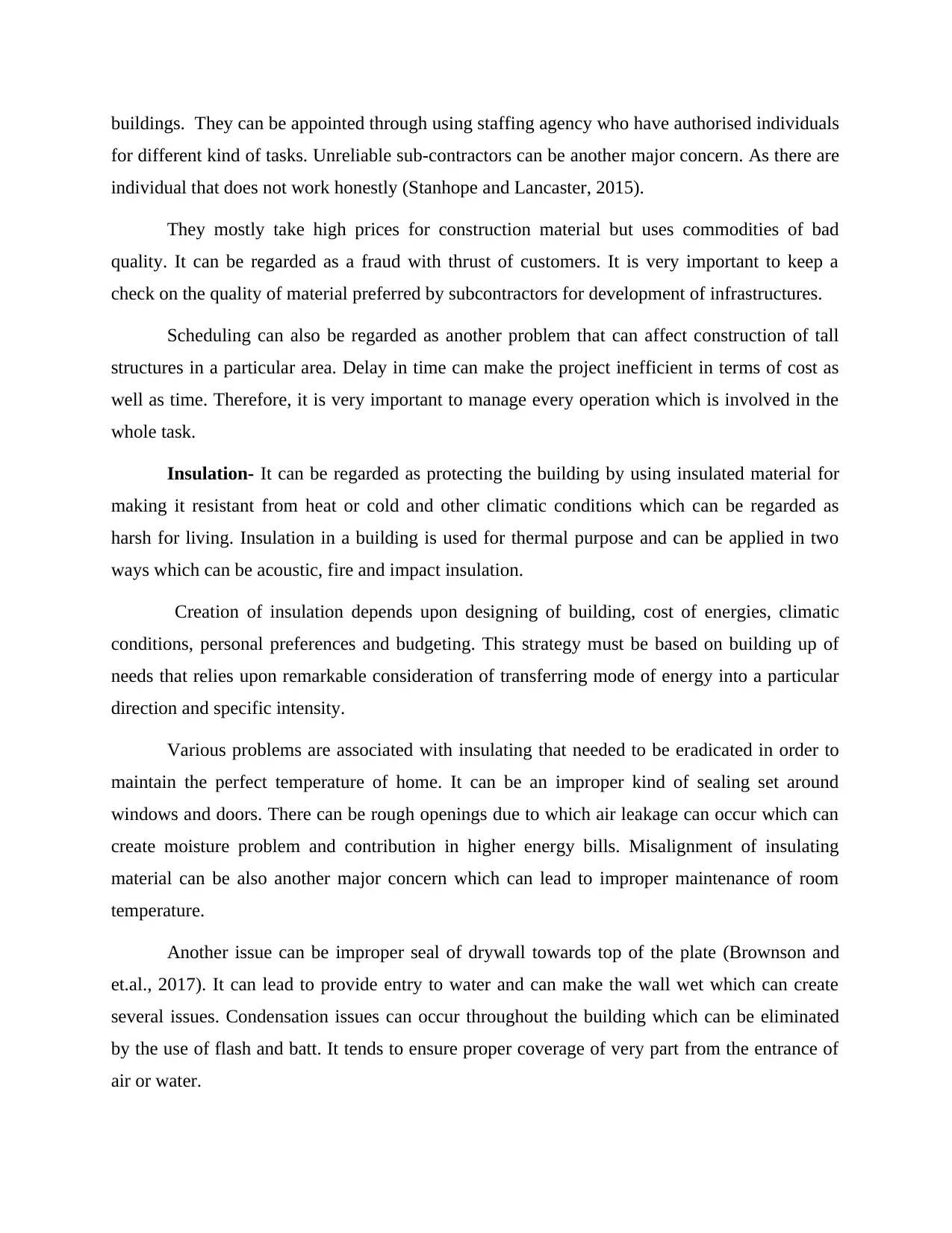
buildings. They can be appointed through using staffing agency who have authorised individuals
for different kind of tasks. Unreliable sub-contractors can be another major concern. As there are
individual that does not work honestly (Stanhope and Lancaster, 2015).
They mostly take high prices for construction material but uses commodities of bad
quality. It can be regarded as a fraud with thrust of customers. It is very important to keep a
check on the quality of material preferred by subcontractors for development of infrastructures.
Scheduling can also be regarded as another problem that can affect construction of tall
structures in a particular area. Delay in time can make the project inefficient in terms of cost as
well as time. Therefore, it is very important to manage every operation which is involved in the
whole task.
Insulation- It can be regarded as protecting the building by using insulated material for
making it resistant from heat or cold and other climatic conditions which can be regarded as
harsh for living. Insulation in a building is used for thermal purpose and can be applied in two
ways which can be acoustic, fire and impact insulation.
Creation of insulation depends upon designing of building, cost of energies, climatic
conditions, personal preferences and budgeting. This strategy must be based on building up of
needs that relies upon remarkable consideration of transferring mode of energy into a particular
direction and specific intensity.
Various problems are associated with insulating that needed to be eradicated in order to
maintain the perfect temperature of home. It can be an improper kind of sealing set around
windows and doors. There can be rough openings due to which air leakage can occur which can
create moisture problem and contribution in higher energy bills. Misalignment of insulating
material can be also another major concern which can lead to improper maintenance of room
temperature.
Another issue can be improper seal of drywall towards top of the plate (Brownson and
et.al., 2017). It can lead to provide entry to water and can make the wall wet which can create
several issues. Condensation issues can occur throughout the building which can be eliminated
by the use of flash and batt. It tends to ensure proper coverage of very part from the entrance of
air or water.
for different kind of tasks. Unreliable sub-contractors can be another major concern. As there are
individual that does not work honestly (Stanhope and Lancaster, 2015).
They mostly take high prices for construction material but uses commodities of bad
quality. It can be regarded as a fraud with thrust of customers. It is very important to keep a
check on the quality of material preferred by subcontractors for development of infrastructures.
Scheduling can also be regarded as another problem that can affect construction of tall
structures in a particular area. Delay in time can make the project inefficient in terms of cost as
well as time. Therefore, it is very important to manage every operation which is involved in the
whole task.
Insulation- It can be regarded as protecting the building by using insulated material for
making it resistant from heat or cold and other climatic conditions which can be regarded as
harsh for living. Insulation in a building is used for thermal purpose and can be applied in two
ways which can be acoustic, fire and impact insulation.
Creation of insulation depends upon designing of building, cost of energies, climatic
conditions, personal preferences and budgeting. This strategy must be based on building up of
needs that relies upon remarkable consideration of transferring mode of energy into a particular
direction and specific intensity.
Various problems are associated with insulating that needed to be eradicated in order to
maintain the perfect temperature of home. It can be an improper kind of sealing set around
windows and doors. There can be rough openings due to which air leakage can occur which can
create moisture problem and contribution in higher energy bills. Misalignment of insulating
material can be also another major concern which can lead to improper maintenance of room
temperature.
Another issue can be improper seal of drywall towards top of the plate (Brownson and
et.al., 2017). It can lead to provide entry to water and can make the wall wet which can create
several issues. Condensation issues can occur throughout the building which can be eliminated
by the use of flash and batt. It tends to ensure proper coverage of very part from the entrance of
air or water.
⊘ This is a preview!⊘
Do you want full access?
Subscribe today to unlock all pages.

Trusted by 1+ million students worldwide
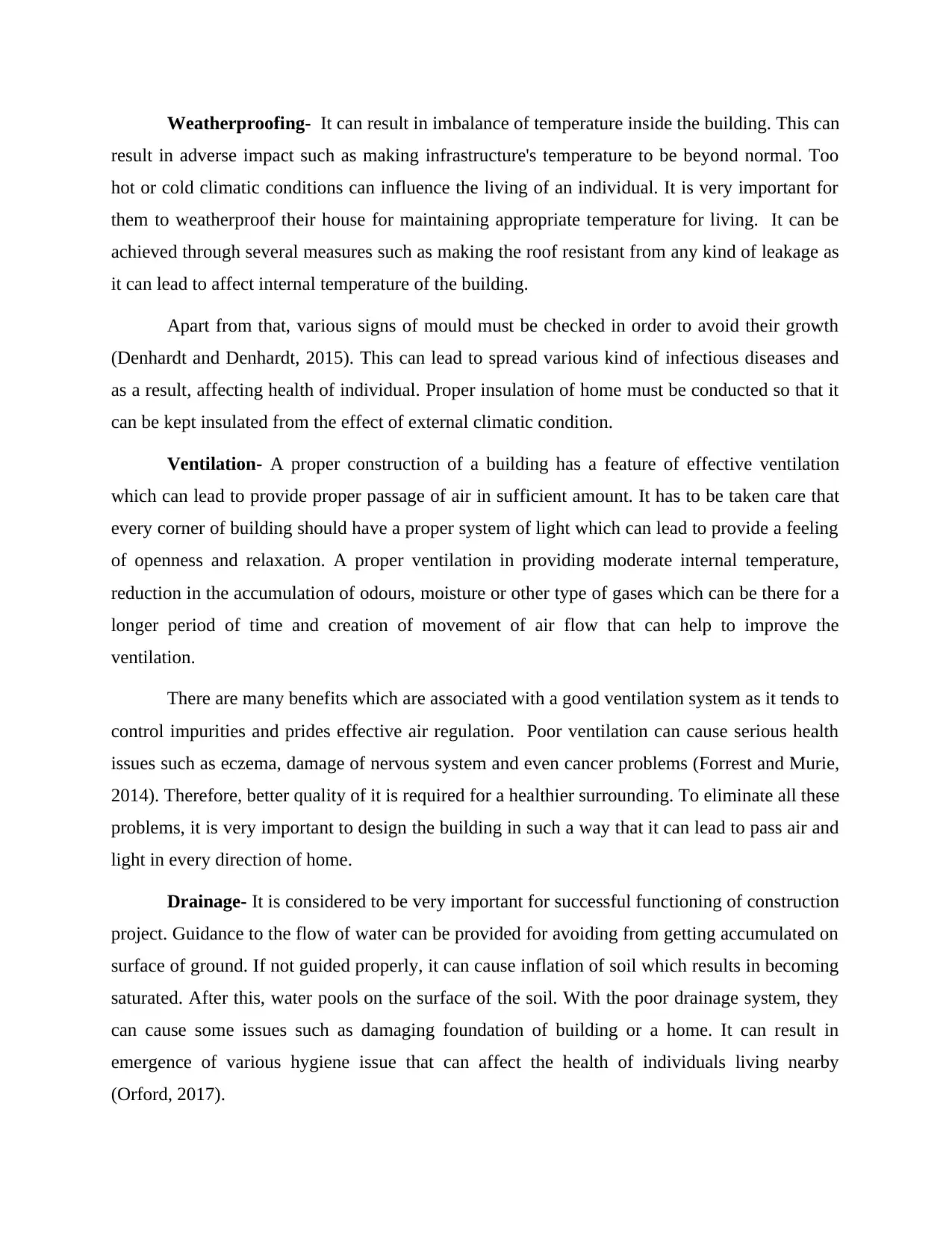
Weatherproofing- It can result in imbalance of temperature inside the building. This can
result in adverse impact such as making infrastructure's temperature to be beyond normal. Too
hot or cold climatic conditions can influence the living of an individual. It is very important for
them to weatherproof their house for maintaining appropriate temperature for living. It can be
achieved through several measures such as making the roof resistant from any kind of leakage as
it can lead to affect internal temperature of the building.
Apart from that, various signs of mould must be checked in order to avoid their growth
(Denhardt and Denhardt, 2015). This can lead to spread various kind of infectious diseases and
as a result, affecting health of individual. Proper insulation of home must be conducted so that it
can be kept insulated from the effect of external climatic condition.
Ventilation- A proper construction of a building has a feature of effective ventilation
which can lead to provide proper passage of air in sufficient amount. It has to be taken care that
every corner of building should have a proper system of light which can lead to provide a feeling
of openness and relaxation. A proper ventilation in providing moderate internal temperature,
reduction in the accumulation of odours, moisture or other type of gases which can be there for a
longer period of time and creation of movement of air flow that can help to improve the
ventilation.
There are many benefits which are associated with a good ventilation system as it tends to
control impurities and prides effective air regulation. Poor ventilation can cause serious health
issues such as eczema, damage of nervous system and even cancer problems (Forrest and Murie,
2014). Therefore, better quality of it is required for a healthier surrounding. To eliminate all these
problems, it is very important to design the building in such a way that it can lead to pass air and
light in every direction of home.
Drainage- It is considered to be very important for successful functioning of construction
project. Guidance to the flow of water can be provided for avoiding from getting accumulated on
surface of ground. If not guided properly, it can cause inflation of soil which results in becoming
saturated. After this, water pools on the surface of the soil. With the poor drainage system, they
can cause some issues such as damaging foundation of building or a home. It can result in
emergence of various hygiene issue that can affect the health of individuals living nearby
(Orford, 2017).
result in adverse impact such as making infrastructure's temperature to be beyond normal. Too
hot or cold climatic conditions can influence the living of an individual. It is very important for
them to weatherproof their house for maintaining appropriate temperature for living. It can be
achieved through several measures such as making the roof resistant from any kind of leakage as
it can lead to affect internal temperature of the building.
Apart from that, various signs of mould must be checked in order to avoid their growth
(Denhardt and Denhardt, 2015). This can lead to spread various kind of infectious diseases and
as a result, affecting health of individual. Proper insulation of home must be conducted so that it
can be kept insulated from the effect of external climatic condition.
Ventilation- A proper construction of a building has a feature of effective ventilation
which can lead to provide proper passage of air in sufficient amount. It has to be taken care that
every corner of building should have a proper system of light which can lead to provide a feeling
of openness and relaxation. A proper ventilation in providing moderate internal temperature,
reduction in the accumulation of odours, moisture or other type of gases which can be there for a
longer period of time and creation of movement of air flow that can help to improve the
ventilation.
There are many benefits which are associated with a good ventilation system as it tends to
control impurities and prides effective air regulation. Poor ventilation can cause serious health
issues such as eczema, damage of nervous system and even cancer problems (Forrest and Murie,
2014). Therefore, better quality of it is required for a healthier surrounding. To eliminate all these
problems, it is very important to design the building in such a way that it can lead to pass air and
light in every direction of home.
Drainage- It is considered to be very important for successful functioning of construction
project. Guidance to the flow of water can be provided for avoiding from getting accumulated on
surface of ground. If not guided properly, it can cause inflation of soil which results in becoming
saturated. After this, water pools on the surface of the soil. With the poor drainage system, they
can cause some issues such as damaging foundation of building or a home. It can result in
emergence of various hygiene issue that can affect the health of individuals living nearby
(Orford, 2017).
Paraphrase This Document
Need a fresh take? Get an instant paraphrase of this document with our AI Paraphraser
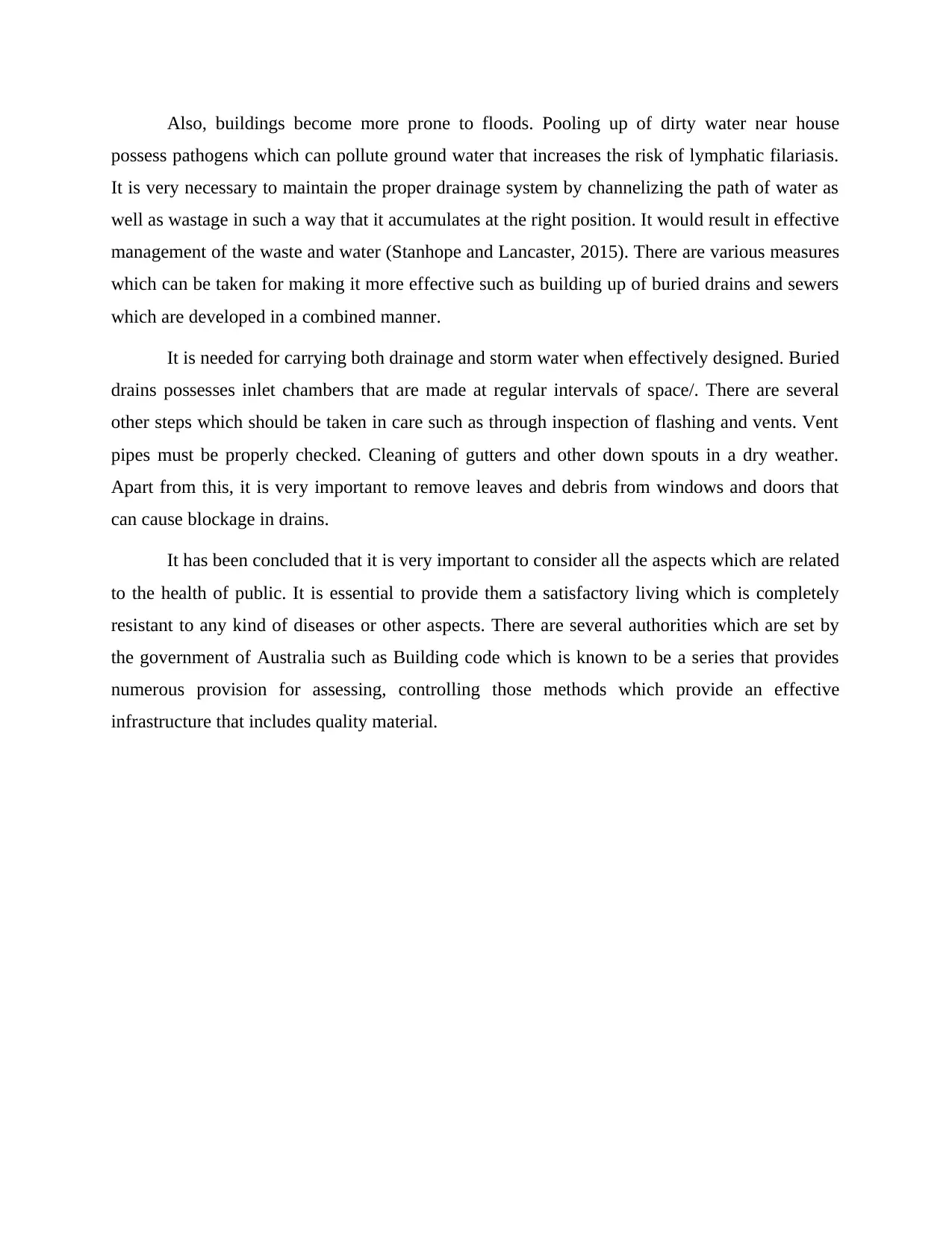
Also, buildings become more prone to floods. Pooling up of dirty water near house
possess pathogens which can pollute ground water that increases the risk of lymphatic filariasis.
It is very necessary to maintain the proper drainage system by channelizing the path of water as
well as wastage in such a way that it accumulates at the right position. It would result in effective
management of the waste and water (Stanhope and Lancaster, 2015). There are various measures
which can be taken for making it more effective such as building up of buried drains and sewers
which are developed in a combined manner.
It is needed for carrying both drainage and storm water when effectively designed. Buried
drains possesses inlet chambers that are made at regular intervals of space/. There are several
other steps which should be taken in care such as through inspection of flashing and vents. Vent
pipes must be properly checked. Cleaning of gutters and other down spouts in a dry weather.
Apart from this, it is very important to remove leaves and debris from windows and doors that
can cause blockage in drains.
It has been concluded that it is very important to consider all the aspects which are related
to the health of public. It is essential to provide them a satisfactory living which is completely
resistant to any kind of diseases or other aspects. There are several authorities which are set by
the government of Australia such as Building code which is known to be a series that provides
numerous provision for assessing, controlling those methods which provide an effective
infrastructure that includes quality material.
possess pathogens which can pollute ground water that increases the risk of lymphatic filariasis.
It is very necessary to maintain the proper drainage system by channelizing the path of water as
well as wastage in such a way that it accumulates at the right position. It would result in effective
management of the waste and water (Stanhope and Lancaster, 2015). There are various measures
which can be taken for making it more effective such as building up of buried drains and sewers
which are developed in a combined manner.
It is needed for carrying both drainage and storm water when effectively designed. Buried
drains possesses inlet chambers that are made at regular intervals of space/. There are several
other steps which should be taken in care such as through inspection of flashing and vents. Vent
pipes must be properly checked. Cleaning of gutters and other down spouts in a dry weather.
Apart from this, it is very important to remove leaves and debris from windows and doors that
can cause blockage in drains.
It has been concluded that it is very important to consider all the aspects which are related
to the health of public. It is essential to provide them a satisfactory living which is completely
resistant to any kind of diseases or other aspects. There are several authorities which are set by
the government of Australia such as Building code which is known to be a series that provides
numerous provision for assessing, controlling those methods which provide an effective
infrastructure that includes quality material.
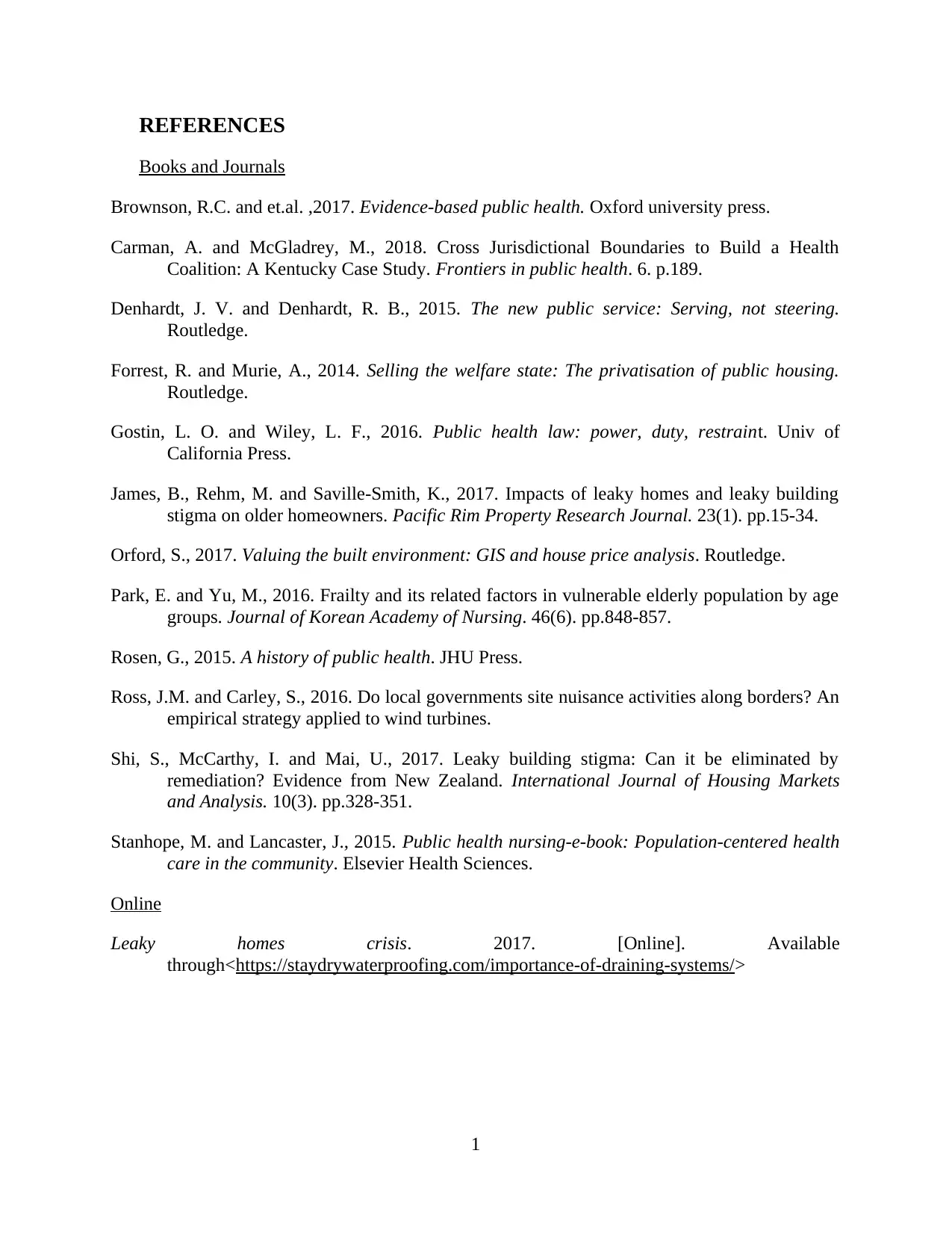
REFERENCES
Books and Journals
Brownson, R.C. and et.al. ,2017. Evidence-based public health. Oxford university press.
Carman, A. and McGladrey, M., 2018. Cross Jurisdictional Boundaries to Build a Health
Coalition: A Kentucky Case Study. Frontiers in public health. 6. p.189.
Denhardt, J. V. and Denhardt, R. B., 2015. The new public service: Serving, not steering.
Routledge.
Forrest, R. and Murie, A., 2014. Selling the welfare state: The privatisation of public housing.
Routledge.
Gostin, L. O. and Wiley, L. F., 2016. Public health law: power, duty, restraint. Univ of
California Press.
James, B., Rehm, M. and Saville-Smith, K., 2017. Impacts of leaky homes and leaky building
stigma on older homeowners. Pacific Rim Property Research Journal. 23(1). pp.15-34.
Orford, S., 2017. Valuing the built environment: GIS and house price analysis. Routledge.
Park, E. and Yu, M., 2016. Frailty and its related factors in vulnerable elderly population by age
groups. Journal of Korean Academy of Nursing. 46(6). pp.848-857.
Rosen, G., 2015. A history of public health. JHU Press.
Ross, J.M. and Carley, S., 2016. Do local governments site nuisance activities along borders? An
empirical strategy applied to wind turbines.
Shi, S., McCarthy, I. and Mai, U., 2017. Leaky building stigma: Can it be eliminated by
remediation? Evidence from New Zealand. International Journal of Housing Markets
and Analysis. 10(3). pp.328-351.
Stanhope, M. and Lancaster, J., 2015. Public health nursing-e-book: Population-centered health
care in the community. Elsevier Health Sciences.
Online
Leaky homes crisis. 2017. [Online]. Available
through<https://staydrywaterproofing.com/importance-of-draining-systems/>
1
Books and Journals
Brownson, R.C. and et.al. ,2017. Evidence-based public health. Oxford university press.
Carman, A. and McGladrey, M., 2018. Cross Jurisdictional Boundaries to Build a Health
Coalition: A Kentucky Case Study. Frontiers in public health. 6. p.189.
Denhardt, J. V. and Denhardt, R. B., 2015. The new public service: Serving, not steering.
Routledge.
Forrest, R. and Murie, A., 2014. Selling the welfare state: The privatisation of public housing.
Routledge.
Gostin, L. O. and Wiley, L. F., 2016. Public health law: power, duty, restraint. Univ of
California Press.
James, B., Rehm, M. and Saville-Smith, K., 2017. Impacts of leaky homes and leaky building
stigma on older homeowners. Pacific Rim Property Research Journal. 23(1). pp.15-34.
Orford, S., 2017. Valuing the built environment: GIS and house price analysis. Routledge.
Park, E. and Yu, M., 2016. Frailty and its related factors in vulnerable elderly population by age
groups. Journal of Korean Academy of Nursing. 46(6). pp.848-857.
Rosen, G., 2015. A history of public health. JHU Press.
Ross, J.M. and Carley, S., 2016. Do local governments site nuisance activities along borders? An
empirical strategy applied to wind turbines.
Shi, S., McCarthy, I. and Mai, U., 2017. Leaky building stigma: Can it be eliminated by
remediation? Evidence from New Zealand. International Journal of Housing Markets
and Analysis. 10(3). pp.328-351.
Stanhope, M. and Lancaster, J., 2015. Public health nursing-e-book: Population-centered health
care in the community. Elsevier Health Sciences.
Online
Leaky homes crisis. 2017. [Online]. Available
through<https://staydrywaterproofing.com/importance-of-draining-systems/>
1
⊘ This is a preview!⊘
Do you want full access?
Subscribe today to unlock all pages.

Trusted by 1+ million students worldwide
1 out of 14
Related Documents
Your All-in-One AI-Powered Toolkit for Academic Success.
+13062052269
info@desklib.com
Available 24*7 on WhatsApp / Email
![[object Object]](/_next/static/media/star-bottom.7253800d.svg)
Unlock your academic potential
Copyright © 2020–2025 A2Z Services. All Rights Reserved. Developed and managed by ZUCOL.




